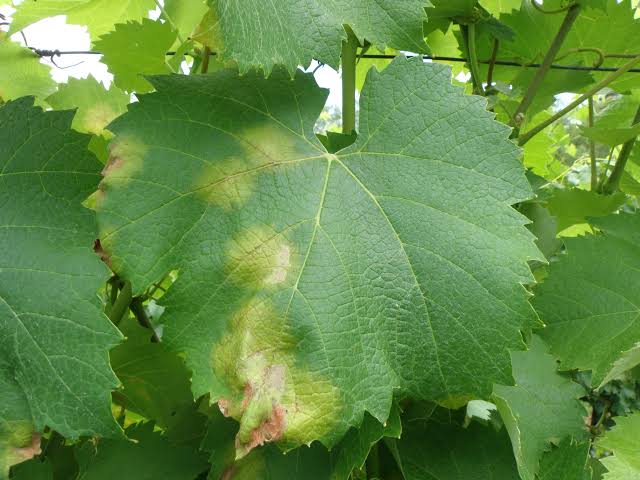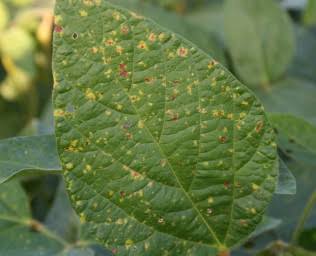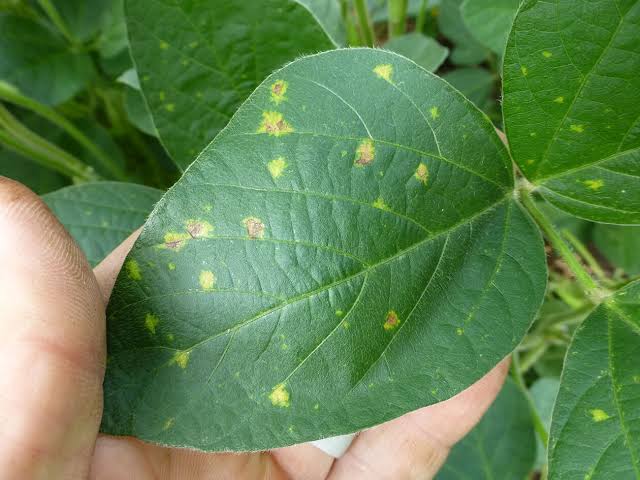Downy mildew, scientifically known as Peronospora, is a plant disease caused by various species of fungi. These fungi belong to the oomycetes group, which are microorganisms distinct from true fungi. Downy mildew primarily affects plants, causing damage to crops and ornamental plants alike.
The name “downy mildew” is derived from the characteristic downy or fluffy growth of the fungus on the lower surfaces of infected leaves. This growth is often mistaken for mold but is a result of the fungus producing spores. These spores can be easily dispersed by wind, water, or even on infected plant material.
One of the most common hosts for downy mildew is the grapevine. Grapevines affected by downy mildew may exhibit yellowing of leaves, decreased fruit quality, and even premature leaf drop. This can significantly impact the productivity of vineyards and, consequently, the production of grapes for winemaking.
Another notable host for downy mildew is the cucumber plant. Infected cucumber leaves may develop yellow spots that eventually turn brown. The fungus can spread rapidly, leading to wilting of the plant and a reduction in fruit yield. Farmers and gardeners often face challenges in managing downy mildew in cucumber crops.
To control downy mildew, various strategies can be employed. These may include the use of fungicides, practicing crop rotation, and selecting resistant plant varieties. Additionally, maintaining proper spacing between plants and providing adequate ventilation can help reduce the humidity levels that favor the growth of the fungus.
Despite efforts to control downy mildew, its impact on agriculture and horticulture remains significant. The economic consequences of crop losses and the cost of implementing control measures underscore the importance of ongoing research to develop more effective and sustainable solutions.
In addition, downy mildew, scientifically known as Peronospora, poses a substantial threat to various plants, impacting agriculture and ornamental plant cultivation. Understanding its characteristics, host range, and control methods is crucial for farmers, gardeners, and researchers working towards mitigating the effects of this widespread plant disease.
Read Also:17 Medicinal Health Benefits Of Mucuna pruriens (Monkey Tamarind)
Plants Affected by Downy Mildew (Peronospora)

Downy mildew can affect a wide range of plants, causing damage to crops and ornamental plants alike. Some of the commonly affected plants include:
1. Grapes (Vitis vinifera): Downy mildew is a significant concern for grape growers. It can lead to reduced grape quality, yield losses, and negatively impact the wine industry.
2. Cucumbers (Cucumis sativus): Cucumber plants are highly susceptible to downy mildew. Infected leaves may develop yellow spots that turn brown, leading to wilting and a decrease in fruit production.
3. Potatoes (Solanum tuberosum): Downy mildew can affect potato plants, causing foliage to yellow and die prematurely. This can result in lower potato yields and affect tuber quality.
4. Lettuce (Lactuca sativa): Lettuce is another common target of downy mildew. Infected plants may exhibit yellowing, wilting, and a decline in overall crop quality.
5. Onions (Allium cepa): Downy mildew can impact onion crops, leading to yellowing and death of foliage. This can reduce bulb size and affect onion quality.
6. Spinach (Spinacia oleracea): Spinach plants are susceptible to downy mildew, which can cause yellowing and lesions on the leaves, affecting the overall health of the plant.
7. Sunflowers (Helianthus annuus): Downy mildew can affect sunflower plants, leading to yellowing, wilting, and a decrease in seed production.
8. Impatiens (Impatiens walleriana): Ornamental plants like impatiens can also be affected by downy mildew, causing yellowing, stunted growth, and reduced flower production.
9. Basil (Ocimum basilicum): Basil is susceptible to downy mildew, resulting in yellowing and browning of leaves, which can impact the flavor and quality of the herb.
10. Hops (Humulus lupulus): Downy mildew can affect hop plants, leading to reduced cone quality and yield, which is significant for the brewing industry.
Understanding the specific plants susceptible to downy mildew is crucial for farmers, gardeners, and horticulturists in implementing effective disease management strategies. Crop rotation, resistant varieties, and timely application of fungicides are some of the approaches used to mitigate the impact of downy mildew on these plants.
Damages Caused by Downy Mildew

Downy mildew can inflict various damages on plants, affecting both crop yield and quality. The specific damages caused by downy mildew include:
1. Reduced Yield: One of the primary impacts of downy mildew is a significant reduction in crop yield. This can be particularly detrimental for agricultural crops such as grapes, cucumbers, and potatoes, leading to economic losses for farmers.
2. Quality Degradation: Downy mildew often results in a decline in the quality of the affected plants. For example, in grapevines, the quality of the grapes used for winemaking can be compromised, affecting the taste and characteristics of the final product.
3. Premature Leaf Drop: Infected plants may experience premature leaf drop, leading to a loss of foliage. This not only reduces the plant’s ability to photosynthesize but also affects the overall health and vigor of the plant.
4. Stunted Growth: Downy mildew can stunt the growth of plants, limiting their potential size and development. This is particularly evident in ornamental plants and crops such as lettuce and spinach.
5. Wilting and Yellowing: Infected plants often exhibit symptoms of wilting and yellowing. The leaves may show discoloration, affecting the plant’s ability to produce energy through photosynthesis.
6. Loss of Aesthetic Value: Ornamental plants affected by downy mildew, like impatiens, can experience a loss of aesthetic value. Stunted growth, leaf discoloration, and reduced flower production diminish the visual appeal of these plants.
7. Seed and Tuber Damage: Crops such as sunflowers and potatoes can experience damage to seeds and tubers, leading to reduced seed quality and storage issues.
8. Increased Susceptibility to Other Diseases: Downy mildew weakens the plant’s immune system, making it more susceptible to other diseases. This can create a domino effect, further compromising the overall health of the plant.
9. Impact on Agricultural Industries: The damages caused by downy mildew have broader implications for agricultural industries. Reduced yields and lower-quality crops can affect supply chains, market prices, and the livelihoods of farmers and stakeholders in the affected sectors.
10. Environmental Impact: In cases where downy mildew affects natural ecosystems or native plant species, there can be ecological consequences. Changes in plant populations can influence the dynamics of local ecosystems.
Addressing downy mildew damages involves implementing effective management strategies, including the use of resistant varieties, cultural practices, and timely application of fungicides. Continuous research and collaboration within the agricultural and horticultural communities are crucial to developing sustainable solutions to mitigate the impact of downy mildew on crops and plants.
Read Also: 18 Medicinal Health Benefits Of Litsea garciae (Engkalak)
Control and Preventive Measures

Controlling and preventing downy mildew involves a combination of cultural, chemical, and biological strategies. Here are some effective measures to manage and prevent the spread of downy mildew:
1. Resistant Varieties: Planting resistant varieties is a key strategy. Selecting and cultivating plant varieties that have natural resistance to downy mildew can significantly reduce the risk of infection.
2. Crop Rotation: Implementing a crop rotation system helps break the disease cycle. Avoid planting susceptible crops in the same location consecutively, as this reduces the buildup of downy mildew spores in the soil.
3. Proper Spacing: Ensure adequate spacing between plants to promote air circulation. Improved ventilation helps reduce humidity levels around the foliage, creating an environment less favorable for downy mildew development.
4. Avoiding Overhead Irrigation: Minimize the use of overhead irrigation, as it can create conditions conducive to downy mildew. Drip irrigation or soaker hoses direct water to the base of plants, reducing moisture on foliage.
5. Fungicide Application: Fungicides can be used as a preventive or curative measure. Timely application of fungicides, following recommended guidelines, can help control downy mildew. However, it’s essential to rotate fungicides to prevent the development of resistant strains.
6. Early Detection and Removal: Regularly inspect plants for symptoms of downy mildew. Early detection allows for prompt action. Remove and destroy infected plant parts to prevent the further spread of the disease.
7. Proper Pruning: Prune plants to improve air circulation and remove infected plant material. This practice helps reduce the severity of downy mildew and prevents the disease from spreading.
8. Biocontrol Agents: Introduce beneficial microorganisms or predators that can act as natural enemies of downy mildew. Biocontrol agents, such as certain bacteria or fungi, can help manage the disease in an environmentally friendly manner.
9. Cultural Practices: Adopting good cultural practices, such as proper fertilization, can enhance plant health and resilience against diseases like downy mildew.
10. Quarantine Measures: If downy mildew is detected, implement quarantine measures to prevent the movement of infected plants or plant material to other areas. This helps contain the spread of the disease.
11. Weather Monitoring: Stay informed about weather conditions, as downy mildew thrives in humid and wet environments. Adjust preventive measures accordingly during periods of high humidity or rainfall.
12. Educational Outreach: Educate farmers, gardeners, and the public about the signs and symptoms of downy mildew, as well as effective prevention and control measures. Awareness plays a crucial role in managing the disease.
Implementing a holistic and integrated approach that combines several of these measures is often the most effective way to control and prevent downy mildew. It’s important to tailor strategies to specific crops and environmental conditions while considering the sustainability of the chosen practices. Regular monitoring and adaptability are key components of successful downy mildew management.
Frequently Asked Questions (FAQs) About Downy Mildew (Peronospora)
1. Q: What is Downy mildew?
A: Downy mildew is a plant disease caused by various fungi from the oomycetes group. It affects a wide range of plants, leading to significant economic losses in agriculture and horticulture.
2. Q: What are the common symptoms of Downy mildew?
A: Symptoms include yellowing of leaves, downy or fluffy growth on the lower leaf surfaces, wilting, premature leaf drop, and a decline in overall plant health.
3. Q: Which plants are commonly affected by Downy mildew?
A: Common hosts include grapes, cucumbers, potatoes, lettuce, onions, spinach, sunflowers, impatiens, basil, and hops.
4. Q: How does Downy mildew spread?
A: Downy mildew spreads through spores produced on the undersides of infected leaves. Wind, water, and movement of infected plant material contribute to its dissemination.
5. Q: Can Downy mildew affect ornamental plants?
A: Yes, ornamental plants like impatiens can be susceptible to Downy mildew, leading to a loss of aesthetic value and reduced flower production.
6. Q: What are the economic impacts of Downy mildew?
A: Downy mildew can result in reduced crop yield, lower quality produce, and economic losses for farmers. It also affects industries such as winemaking and brewing.
7. Q: How can Downy mildew be controlled?
A: Control measures include planting resistant varieties, crop rotation, proper spacing, avoiding overhead irrigation, fungicide application, early detection, and removal of infected plant material.
8. Q: Are there natural ways to control Downy mildew?
A: Yes, biocontrol agents, such as beneficial microorganisms or predators, can be introduced to manage Downy mildew in an environmentally friendly manner.
9. Q: Can Downy mildew be prevented?
A: Prevention involves implementing measures like choosing resistant plant varieties, practicing proper crop rotation, maintaining good air circulation, and monitoring weather conditions.
10. Q: What should I do if I suspect Downy mildew in my plants?
A: If you suspect Downy mildew, promptly inspect your plants for symptoms, remove and destroy infected parts, and consider consulting with agricultural extension services for further guidance.
11. Q: Is Downy mildew harmful to humans?
A: Downy mildew primarily affects plants and does not pose a direct threat to human health. However, its impact on crops can have significant economic and nutritional implications for human populations.
Read Also: Environmental Management Tips for Sustainable Living

